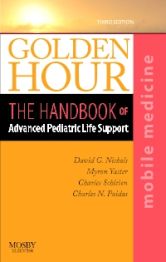"Highly Commended," Paediatrics Category, British Medical Association 2012 Medical Book Competition
New to this edition
- Prepare for a broad range of emergency situations with new chapters on General Surgical Emergencies; Asthma; Acute Renal Failure; Diabetic Ketoacidosis; Gastrointestinal Emergencies; Liver Failure; Hematologic and Oncologic Emergencies; Hypo/Hyperthermia; and Terrorism and Mass Casualty.
- Solve more clinical challenges with new and expanded material, including spinal cord trauma, and additional focus on the hot topic of pain and sedation.
- Get expert visual guidance with additional illustrations to supplement the comprehensive coverage.
Key Features
Find what you need quickly when performing emergency techniques such as cardioversion/defibrillation with a step-by-step, outline format that includes numerous algorithms, tables, and figures.
Author Information
By David G. Nichols, MD, Mary Wallace Stanton Professor of Education and Vice Dean for Education, Dean’s Office, Johns Hopkins University School of Medicine; Professor, Department of Anesthesiology and Critical Care Medicine; Professor, Department of Pediatrics, Johns Hopkins Hospital, Baltimore, Maryland; Myron Yaster, MD, Richard J. Traystman Distinguished Professor, Department of Anesthesiology, Critical Care Medicine, and Pediatrics, Johns Hopkins University School of Medicine, Baltimore, Maryland; Charles Schleien, MD, MBA, Executive Vice Chairman, Professor of Pediatrics & Anesthesiology, Columbia University, New York, New York and Charles N. Paidas, MD, Professor of Surgery & Pediatrics, Chief of Surgery, Associate Dean for Graduate Medical Education, Executive Associate Dean for Clinical and Extramural Affairs, University of South Florida Health, College of Medicine, Tampa, Florida
1. Initial Assessment
2. Airway Management
3. Respiratory Failure
4. Acute Asthma
5. Cardiopulmonary Resuscitation
6. Shock
7. Cardiovascular Emergencies
8. Electrolyte and Metabolic Disorders
9. Acute Renal Failure
10. Endocrine Emergencies: Diabetic Ketoacidosis, Hypoglycemia, and Thyroid Storm
11. Gastrointestinal Emergencies
12. Liver Failure
13. Hematologic Emergencies
14. Oncologic Emergencies
15. Head and Spinal Cord Trauma
16. Nontraumatic Stupor and Coma
17. Drug Intoxication
18. Status Epilepticus
19. Meningitis and Sepsis
20. Pain Control and Sedation Management
21. Thoracic Trauma
22. Abdominal Trauma
23. General Surgical Emergencies
24. Orthopedic Trauma
25. Ocular Emergencies and Trauma
26. Soft Tissue Injuries
27. Human and Animal Bites and Stings
28. Hypothermia and Hyperthermia
29. Terrorism and Mass Casualty Events
30. Burns
31. Child Abuse
32. Neonatal Emergencies
33. Transportation of the Critically Ill and Injured Child
"It provides a systematic approach to the care of the critically ill/injured child during the initial hour after presentation. A particularly relevant new chapter on terrorism and mass casualty events is extremely informative.The quality of this book is exceptional for the targeted audience. The inclusion of new chapters on terrorism and mass casualty events justifies the replacement of the previous edition." - Richelle Monier, MD (Ochsner Clinic Foundation) 5 star Doody Rating!














